Afghanistan, a nation in southwest Asia, has towering mountains, scorching deserts, fertile valleys, and rolling plains. Afghanistan is completely surrounded by six other countries and has no seacoast. It is bordered by Turkmenistan, Uzbekistan, and Tajikistan on the north, China on the far northeast, Pakistan on the east and south, and Iran on the west.
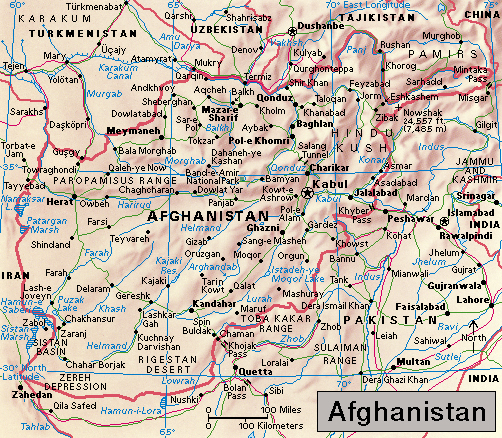
Afghanistan is one of the world’s least developed countries. Decades of war have devastated the country. Many Afghan workers farm small plots of land. Since the beginning of the 2000’s, there has been a large migration of people to the cities, especially to Kabul, the country’s capital and largest city.

Almost all the people of Afghanistan are Muslims. The population of Afghanistan consists of numerous ethnic groups. Many of the ethnic groups have distinct languages and cultures.
Afghanistan has a long and complicated history. It has been invaded and conquered by numerous peoples and powers, including Persians, Greeks, and Mongols. From 1979 to 1989, the Soviet Union occupied Afghanistan. Nevertheless, the country also has a rich history of trade and peaceful interactions with its neighbors.
In the 1990’s, a conservative Islamic group called the Taliban came to power. The Taliban allowed international terrorist organizations to run training camps in Afghanistan. After terrorist attacks against the United States in 2001, the United States and anti-Taliban forces within Afghanistan drove the Taliban from power. Afghans, with assistance from the United States, the United Nations, and other international agencies then worked to establish a new democratic government for the country. However, the Taliban eventually regrouped. The U.S. and other international forces withdrew in 2021. As they did so, Taliban forces seized control in Afghanistan.
Government
According to Afghanistan’s 2004 Constitution, the president is head of state. The president and two vice presidents were elected by the people to five-year terms. Afghanistan’s legislature consisted of the Wolesi Jirga (House of the People) and the Meshrano Jirga (House of the Elders). The 250 members of the Wolesi Jirga were elected by the people to five-year terms. The 102 Meshrano Jirga members served terms of varying lengths. One-third of these members were chosen by Afghanistan’s 34 provincial councils, one-third by district councils, and one-third by the president. The men of Afghan communities often hold smaller jirgas (councils) to decide matters of local importance. A Supreme Court is Afghanistan’s highest court. Men and women were guaranteed equal rights under the 2004 Constitution.
Loading the player...Afghanistan's national anthem
After the Taliban seized control of Afghanistan in 2021, they named an interim prime minister and an interim cabinet to run the country. They also called the country the Islamic Emirate of Afghanistan, rather than the Islamic Republic of Afghanistan.
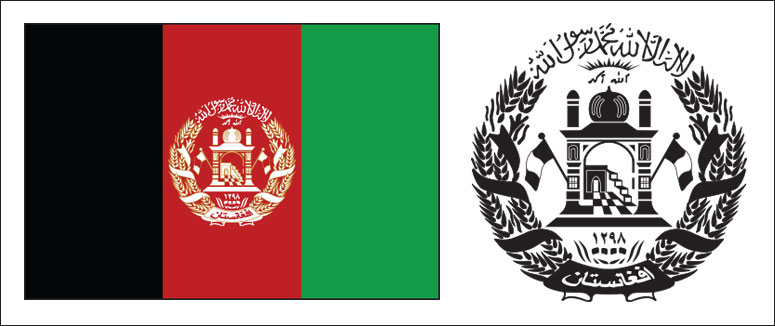
People
Ancestry.
Most Afghans are a blend of early peoples who came to the country as invaders or settlers. These groups included Aryans, Persians, Arabs, Mongolians, Turkic-speaking people from central Asia, and people from the Xinjiang region of western China.
Ethnic groups and languages.
Afghanistan has about 20 ethnic groups, many of which have their own language, culture, and traditions. Some ethnic groups consist of smaller communities known as qawms (pronounced komz), which can be translated as tribe, nation, or family. There can be as much difference between qawms within the same ethnic group as between different ethnic groups.
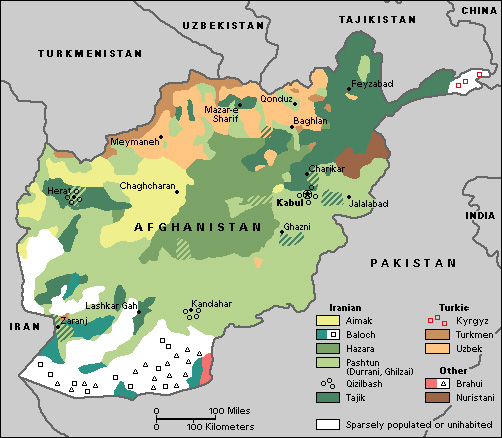
The largest ethnic groups are the Pashtuns (or Pakhtuns) and the Tajiks. The Pashtuns and Tajiks make up about 70 percent of the population. Historically, most Pashtuns lived in the south and east, and Tajiks lived in the north and east of the country. But the violence of the late 1900’s and early 2000’s has led to significant migration within Afghanistan. Other important ethnic groups include the Aimak, Baloch, Hazara, Qizilbash, Turkmen, and Uzbek.
Afghanistan has two official languages—Pashto (or Pakhto) and Dari, which is also known as Afghan Persian. There are a number of local languages spoken by different ethnic groups and communities as well. Many Afghans speak more than one language.
Way of life.
Afghanistan’s rural people live in homes made of sun-dried mud bricks. City dwellers live in modern homes and apartment buildings. A small number of nomadic and seminomadic people live in tents made of goat hair. Nomads are people who move from place to place with their herds of sheep or goats.
Traditional Afghan clothing includes a posteen, a heavy winter coat made of sheepskin, quilted fabric, or felt. Some men wear a turban. Others have traditionally worn a woolen cap called a pakool. Such headwear can indicate a person’s ethnic identity or place of origin. Afghanistan is a socially conservative country, and women are expected to dress modestly and to cover their heads in public. A garment traditionally worn by some women, mainly Pashtuns, covers the body from head to toe and is called a burqa or chadri.
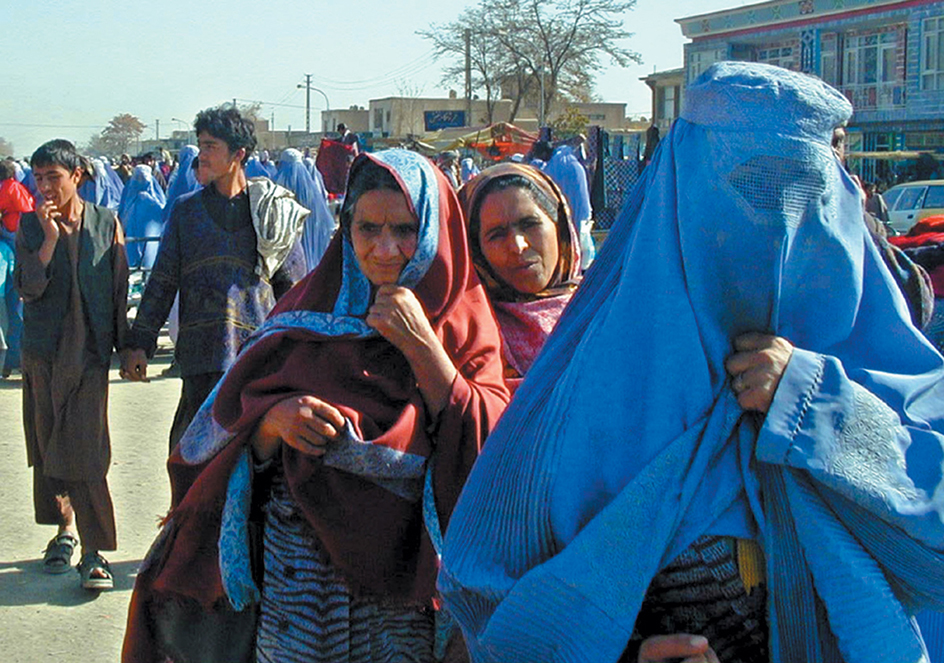
Afghans usually serve flat loaves of whole-grain, sourdough bread at meals. They also enjoy vegetables, yogurt, chicken, beef, mutton, and rice. Popular desserts include nuts and fruits. Tea is the favorite drink.
Women
have traditionally played a secondary role in Afghan society. Their opportunities for education and careers have been limited, especially in rural areas. Afghan society is patriarchal (controlled by men). Some families practice purdah, which involves segregating men and women, except for close relatives, in the home.
During the 1900’s, several Afghan governments gave women more legal rights. In 1964, for example, a new constitution granted Afghan women equal status with men, and the social and economic position of some women improved. In practice, however, few women fully enjoyed these rights.
In the 1990’s and early 2000’s, the Taliban greatly limited the freedom of women. The Taliban required all women to cover themselves completely when in public. They also prohibited women from working outside their homes. Women who violated Taliban laws were punished severely.
After the Taliban fell in 2001, many Afghan women hoped to reclaim their rights. Several women played significant roles in the national councils that created a transitional government and adopted a new constitution for the country. The 2004 Constitution reserved several seats for women in the National Assembly.
The Taliban returned to power in 2021. They soon began to reimpose such restrictions as limiting education for girls, requiring women to wear a face covering when in public, and limiting women’s right to travel unless accompanied by a male relative.
Religion.
Nearly all Afghans are Muslims. Most are Sunni Muslims, though some are Shī`ites. The latter group includes Ismailis, a small religious minority found mainly in Badakhshan in the far northeast. Sufism, the mystical tradition of Islam, has long been important in Afghanistan. Other religious communities, such as Sikhs, are mainly found in Kabul and other large cities.
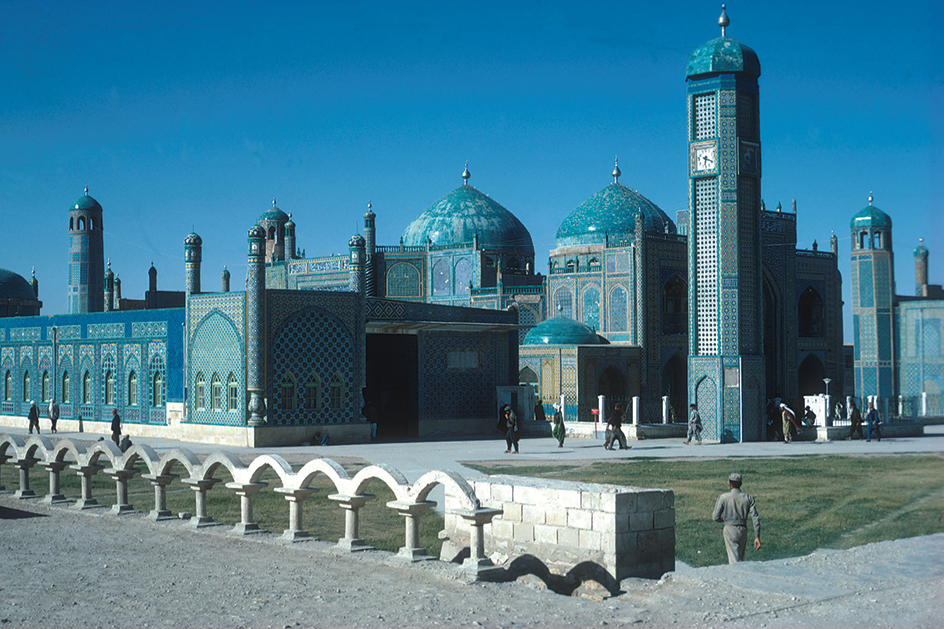
Education.
About 60 percent of Afghanistan’s people 15 years of age or older cannot read and write. The country lacks sufficient schools and teachers, largely due to the upheaval caused by decades of war. In many places, Muslim religious schools called madrasahs have met this need. Afghanistan has a few universities, including Kabul University and Nangarhar University in Jalalabad.
The arts.
Folklore, songs, and dances have played an important part in Afghan life. They have enabled the people to pass their values and traditions on from one generation to the next. The attan (also spelled atan) is an energetic folk dance. Pashtuns traditionally have danced the attan at weddings and other community celebrations. Afghanistan also has a long tradition of poetry, both religious and secular (nonreligious). Poetry competitions continue to be a central source of entertainment and are sometimes broadcast on national radio.
Loading the player...Afghan folk music
Recreation.
Afghans enjoy sports and games, such as soccer and cricket. Men of the northern plains play a game called buzkashi. In the game, dozens of horsemen try to grab a headless calf and carry it across a goal.
The land and climate
Afghanistan is made up of three main land regions. These regions are, from north to south: (1) the Northern Plains, (2) the Central Highlands, and (3) the Southwestern Lowlands.
The Northern Plains
stretch across northern Afghanistan and consist of mountain plateaus and rolling hills. The soil is fertile in the Northern Plains but can be cultivated only where water is available. Large irrigation systems have been built along some rivers in the region, including the Amu Darya. Nomadic and seminomadic people raise sheep and goats on the vast grasslands.
Temperatures in the Northern Plains of Afghanistan average about 38 °F (3 °C) in January and approximately 90 °F (32 °C) in July. The average annual precipitation in the region totals about 7 inches (18 centimeters).
The Central Highlands
cover about two-thirds of Afghanistan. They consist of the Hindu Kush mountain range and its branches. Snow-capped peaks rise about 25,000 feet (7,620 meters) along the Pakistani border in the northeast. The range gradually descends to a rolling plain in the southwest. Kabul lies in a valley in these mountains, surrounded by ridges of the Hindu Kush.
The Central Highlands have an average temperature of about 25 °F (–4 °C) in January and about 75 °F (24 °C) in July. The region receives about 15 inches (38 centimeters) of precipitation yearly.
The Southwestern Lowlands
lie in southern and southwestern Afghanistan and consist mainly of desert or semidesert land. The region is crossed by the Helmand River, which flows from the Hindu Kush to the Sistan Basin on the Iranian border. The basin has several slightly salty lakes and marshes. Barley, corn, fruits, and wheat are grown in the Helmand Valley, which is the site of important irrigation works.
Temperatures in the lowlands of Afghanistan average about 35 °F (2 °C) in January and about 85 °F (29 °C) in July. The average annual precipitation ranges from 2 to 9 inches (5 to 23 centimeters).
Economy
Historically, Afghanistan’s economy has benefited from the country’s location along the Silk Road and other ancient trade routes. The Italian trader Marco Polo’s journals from the 1200’s detail his journey through the country. As these routes died out, Afghanistan’s economy suffered. Afghanistan has long benefited from foreign money through trade, plunder, or international aid. The country’s internal resources have proven insufficient to support government expenditure. Throughout the 1900’s, Afghan governments attempted to develop the country’s economy and to improve educational opportunities. But decades of war and internal struggles at the end of the 1900’s reversed most of these advances.
Agriculture.
Although little of Afghanistan’s land is suitable for farming, many Afghan workers earn at least part of their living from agriculture. Wheat is Afghanistan’s chief crop. Other crops include barley, corn, cotton, fruits, nuts, rice, and vegetables. Agricultural production has been limited since the 1980’s, with war limiting access to machinery, fertilizer, and water.
In the 1980’s, Afghanistan became one of the world’s leading producers of opium, which is used to make the illegal drug heroin. Wartime conditions led many Afghan farmers, especially in the south and northeast, to raise opium poppies rather than grow food crops. In 2000, the Taliban began enforcing a strict ban on poppy farming, but the practice resumed after the Taliban were driven from power in 2001. Despite the efforts of the Afghan government and its allies, Afghanistan produces the vast majority of the world’s opium.
Afghanistan raises beef and dairy cattle, chickens, goats, and sheep. The skins of Karakul sheep, a fat-tailed sheep known for its silky pelt, are especially valuable.
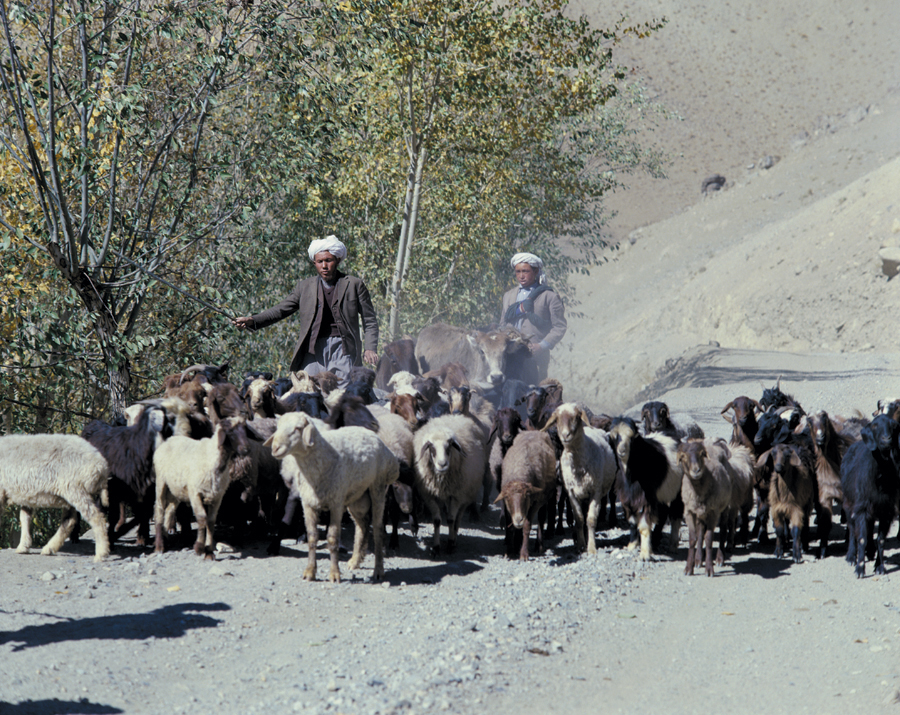
Mining.
Afghanistan is rich in minerals. However, because of the country’s rugged terrain, frequent conflicts, and poor infrastructure, most of the deposits are largely undeveloped. In the 1960’s, large deposits of natural gas were discovered in northern Afghanistan. Since then, the production of natural gas has become an important part of the nation’s economy. Afghanistan also produces some coal and salt. Some of the world’s finest lapis lazuli, a valuable azure-blue stone, and other gemstones are mined in Afghanistan.
Manufacturing.
Afghanistan has little industry because of war damage and a scarcity of raw materials. Skilled craftworkers in their homes or small shops make carpets, leather goods, and other handicraft items. A few mills produce textiles, and small factories turn out such products as cement and processed foods.
International trade.
Illegal opium accounts for much of Afghanistan’s exports. Afghanistan’s leading legal exports include animal skins, carpets, cotton, and fruits and nuts. The country’s leading imports include food, machinery, petroleum products, and textiles. Afghanistan’s main trading partners include China, India, Iran, and Pakistan. Remittances (sums of money sent) from Afghans working overseas are extremely important to the Afghan economy.
Transportation and communication.
Many of Afghanistan’s roads are unpaved. Decades of war have heavily damaged the paved roads, making many of them unusable. The country has limited rail service. Kabul has an international airport.
Afghanistan’s most famous transportation route is the Khyber Pass, which crosses the border between Afghanistan and Pakistan. The pass cuts through the Safid Kuh mountains, which are part of the Hindu Kush range. Conquerors, such as Alexander the Great of Macedonia, used the pass to invade South Asia. The Khyber Pass has been an important trade route for centuries.
Several newspapers are published in Afghanistan. Radio and television stations operate under both private and public ownership. Cell phone usage increased rapidly in the early 2000’s. Few people use the Internet.
History
Prehistoric hunting people lived in what is now Afghanistan as early as 100,000 years ago. After many thousands of years, the people learned how to farm and to herd animals. Agricultural villages then developed. By about 4000 to 2000 B.C., a number of these villages had grown into small cities.
Early invasions.
About 1500 B.C., the Aryans, a central Asian people, invaded the region. Scholars believe they killed many of the area’s inhabitants and intermarried with others. In the mid-500’s B.C., Persians invaded northern Afghanistan, a region then called Bactria. The Persians ruled Bactria until about 330 B.C., when Greeks and Macedonians led by Alexander the Great conquered the region and much of the rest of Afghanistan.
About 246 B.C., the Bactrians revolted. They eventually conquered much of Afghanistan and formed a kingdom that lasted about 150 years. They were conquered by the Kushans of central Asia. Sasanians from Persia invaded in the A.D. 200’s, and White Huns from central Asia defeated the Kushans and Sasanians in the 400’s.
The coming of Islam.
Arab Muslim armies swept into parts of what is now Afghanistan during the late 600’s. Three Muslim dynasties—the Tahirid, the Samanid, and the Saffarid—controlled much of the region during the 800’s and 900’s. Under these dynasties, most local inhabitants converted to Islam.
Turkic-speaking peoples from eastern Persia and central Asia ruled Afghanistan from about 900 to 1200. The most famous of these were the Ghaznavids, who, under Mahmud of Ghazni, conquered much of northern India. Afghanistan was conquered by Mongols led by Genghis Khan in the 1200’s and led by Timur, also called Tamerlane, in the 1300’s. Safavids from Persia and Mughals from India struggled for control of Afghanistan from the mid-1500’s to the early 1700’s.
United Afghanistan.
In 1747, Ahmad Khan Abdalli came to power. He took the title shah (king) and adopted the name Durrani (Pearl of the Age). Ahmad Shah Durrani united the many Pashtun tribes, establishing the Durrani Empire. This marked the beginning of modern Afghanistan, though it included territory stretching far beyond the country’s current borders.
Ahmad Shah established his capital at Kandahar. His son and successor, Timur Shah, moved the capital from Kandahar to Kabul in 1775. Timur Shah and his successors struggled to keep the Afghans united and lost control of most of the territory beyond the current borders of Afghanistan.
In 1819, civil war broke out among rival groups that wanted to rule the country. The war lasted until 1826, when Dost Muhammad Khan gained control. He took the title of amir (prince). Dost Muhammad’s descendants ruled the country for the next 150 years.
The Anglo-Afghan wars.
During the 1800’s, the United Kingdom and Russia competed for control of Afghanistan. The United Kingdom wanted to protect its empire in India, which was threatened by Russia’s expansion in Afghanistan. In 1839, British Indian troops invaded Afghanistan to stop Russia’s perceived influence in the region. The invasion set off the First Anglo-Afghan War, which lasted until the British withdrew in 1842.
In 1878, the United Kingdom invaded the country again, starting the Second Anglo-Afghan War. The British found it difficult to establish control of Afghanistan. They recognized Abdur Rahman Khan as amir in 1880, though his authority was limited to the country’s internal affairs. In return, Abdur Rahman accepted British India’s control of Afghanistan’s foreign relations. Abdur Rahman Khan, often called the “Iron Amir,” strengthened the national government and reduced the power of tribal leaders. After he died in 1901, his policies were continued by his son Habibullah Khan.
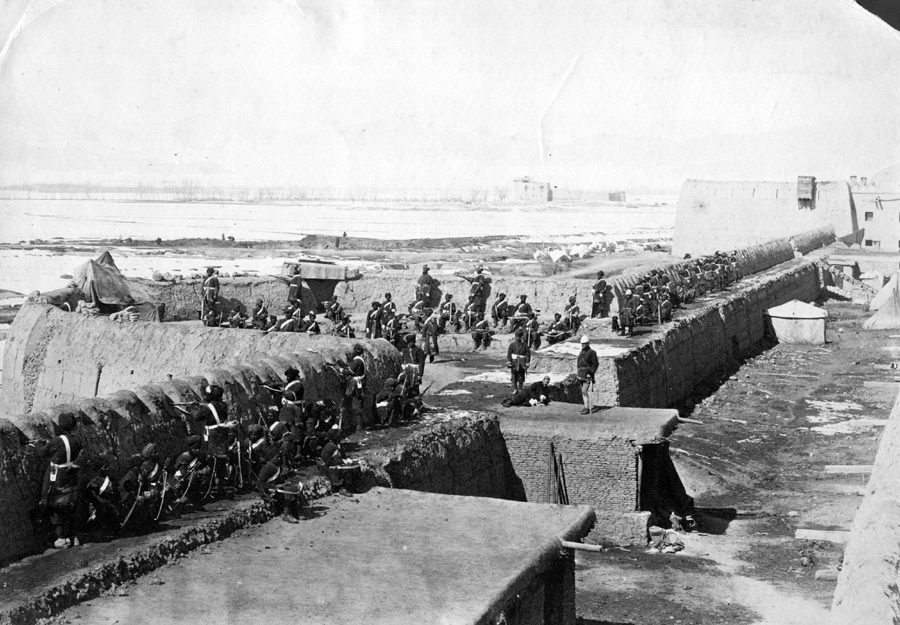
Independence.
Early in 1919, Habibullah Khan was assassinated. One of his sons, Amanullah Khan, then became amir and attacked British troops in India, beginning the Third Anglo-Afghan War. The United Kingdom had just finished fighting in World War I (1914-1918). After a brief conflict, it decided to end its involvement in Afghanistan. In August 1919, Afghanistan became fully independent.
Amanullah began many reforms, challenging long-held traditions and customs. The nation’s first constitution was adopted in 1923, and Amanullah changed his title from amir to shah in 1926. But tribal and religious leaders resisted the reform movement and forced Amanullah Shah to give up the throne in 1929.
Late in 1929, Muhammad Nadir Shah became king. In 1931, Afghanistan adopted a new constitution, under which Nadir Shah planned a program of gradual reform. But he was assassinated in 1933, before many of the reforms were begun. Muhammad Zahir Shah, Nadir Shah’s son, then became king.
The mid-1900’s.
Afghanistan avoided involvement in World War II (1939-1945). By the early 1950’s, Afghanistan had developed good relations with the United States and many Western European nations. But the Afghans feared the intentions of the Soviet Union, their country’s powerful Communist neighbor. In 1953, Muhammad Daoud Khan, the king’s cousin and brother-in-law, took control of the government and made himself prime minister. Under Daoud, Afghanistan took no side in the Cold War, a period of hostility between Communist and non-Communist nations. It received aid from both the United States and the Soviet Union.
Border disputes with Pakistan and other problems led to pressures that forced Daoud to resign in 1963. In 1964, under the leadership of Zahir Shah and Western-educated scholars and thinkers, Afghanistan adopted a constitution that provided for a democratic government for the first time. But many problems arose. Zahir Shah and the legislature could not agree on the role of political parties within the reform program. Parliament often deadlocked on key issues. As a result, the new democratic system failed to bring about the progress that the framers of the Constitution had hoped for.
In 1973, Daoud overthrew Zahir Shah. He established the Republic of Afghanistan and assumed the offices of president and prime minister.
The Soviet invasion.
In 1978, the People’s Democratic Party of Afghanistan (PDPA), the country’s Communist party, overthrew Daoud, who was killed in the uprising. The PDPA established a Communist government.
Many in Afghanistan opposed the new government. They believed the government’s policies conflicted with the teachings of Islam. In addition, they resented Soviet influence on the government. A widespread rebellion against the government soon broke out.
The Soviet Union became concerned that the rebels, who called themselves mujahideen (holy warriors), might defeat the Afghan government forces. On Dec. 25, 1979, the Soviet Union invaded Afghanistan. Over the next decade, the Soviet Union sent more than 100,000 troops to join the fight against the rebels. The Soviets had far better equipment than their opponents. But the rebels were supplied by countries opposed to the Soviet Union, including the United States and Saudi Arabia. The mujahideen used guerrilla tactics to overcome the Soviet advantage. The countryside suffered most from the war. The Soviets and Afghan government forces bombed many villages.
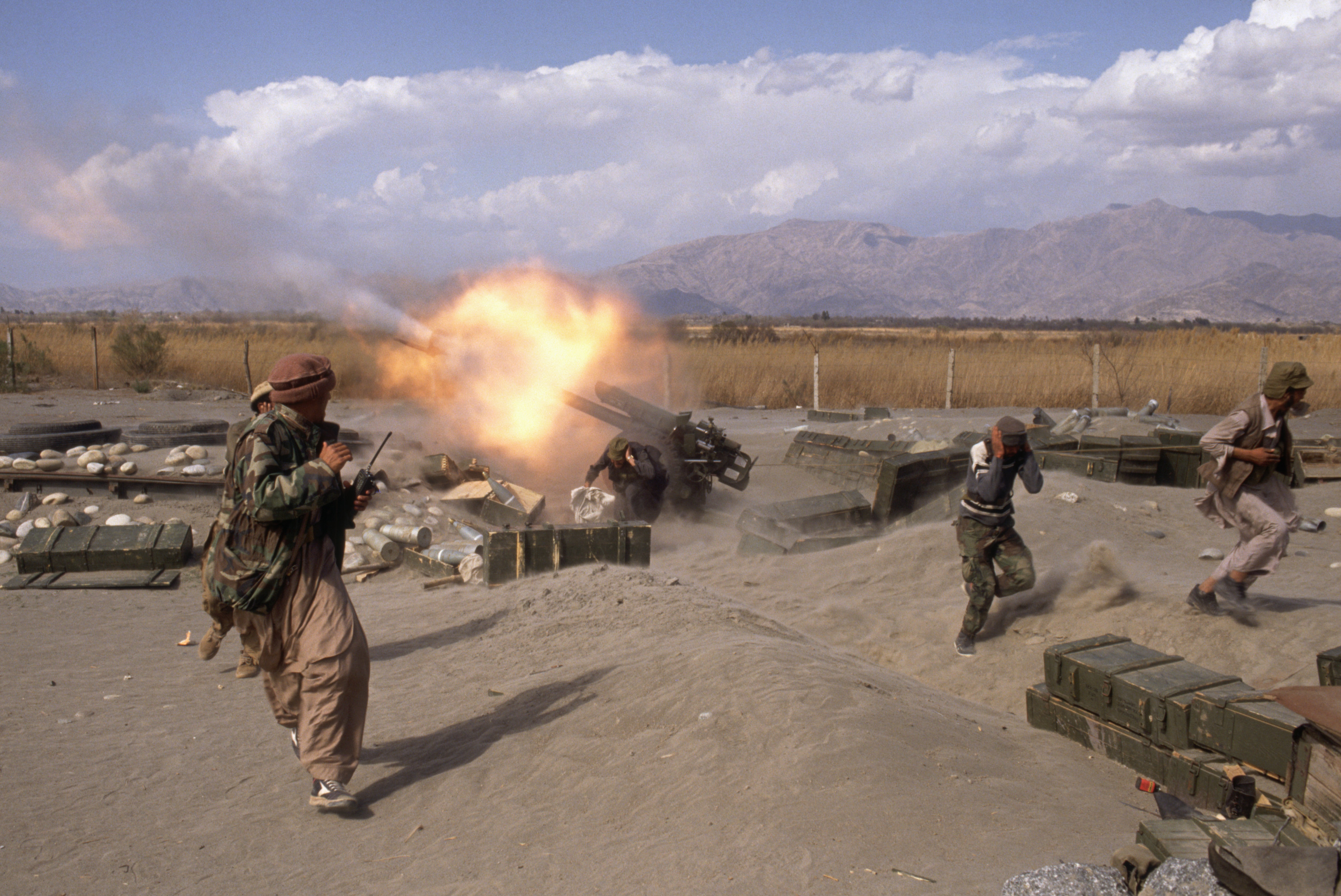
In 1988 and 1989, the Soviet Union withdrew its troops from Afghanistan. But the fighting between the mujahideen and government forces continued until 1992, when the rebels overthrew the government.

Afghanistan under the Taliban.
Continued fighting among mujahideen groups prevented the establishment of a stable government. In the mid-1990’s, a conservative Islamic organization called the Taliban rose to power.
Pashtun religious students who had fled to Pakistan during the Soviet invasion started the Taliban movement. The Taliban were supported by Pakistan’s military and by militant Arab Islamic groups. By the late 1990’s, the Taliban controlled nearly all of Afghanistan. They established a Council of Ministers to rule the country.
The Taliban imposed their strict interpretation of Islam on the people. They banned television and most other modern forms of entertainment, and they established rules for dress and grooming. All women were forced to cover themselves completely when in public, and men were required to grow beards. The Taliban also prohibited girls from attending school and forbade women from working outside the home.
The Taliban destroyed many artifacts of the country’s heritage that they claimed were un-Islamic. They demolished two ancient statues of Buddha carved into a mountainside near Bamyan, a city northwest of Kabul. The Taliban also destroyed many works of art in the country’s museums.

Recent developments.
In 2001, members of a terrorist organization called al-Qa`ida attacked the World Trade Center in New York City and the Pentagon Building near Washington, D.C. (see September 11 terrorist attacks). The United States accused the Taliban of harboring and assisting al-Qa`ida, which had been founded in the late 1980’s by Saudi-born millionaire Osama bin Laden to resist the Soviet occupation of Afghanistan. The United States demanded that the Taliban arrest bin Laden and other al-Qa`ida leaders and shut down their training camps. The Taliban refused to do so, and the United States and its allies launched a military campaign against the Taliban.
The campaign included air strikes in support of the Northern Alliance and other Afghan rebel groups who opposed the Taliban. This support enabled the rebels to drive the Taliban from power in late 2001. An international peacekeeping force known as the International Security and Assistance Force arrived in Kabul in late 2001 and early 2002. In the following years, the force slowly extended its duties from Kabul throughout Afghanistan. However, in the absence of a strong central government, warlords and rebel groups continued to compete, often violently, for territory and power. Small groups of Taliban and al-Qa`ida forces also continued to battle U.S., Afghan, and allied troops.

Meanwhile, the United Nations brought representatives of Afghanistan’s leading groups together in Bonn, Germany, to discuss the formation of a new national government. In June 2002, a loya jirga (grand council) met in Kabul, established a two-year transitional government, and chose Hamid Karzai, a prominent member of the Popalzai tribe, as the country’s transitional president.
In December 2003 and January 2004, another loya jirga met in Kabul and adopted a new constitution for Afghanistan. In October 2004, a presidential election was held under the new Constitution, and Karzai was elected president. Parliamentary and provincial elections were held in September 2005.
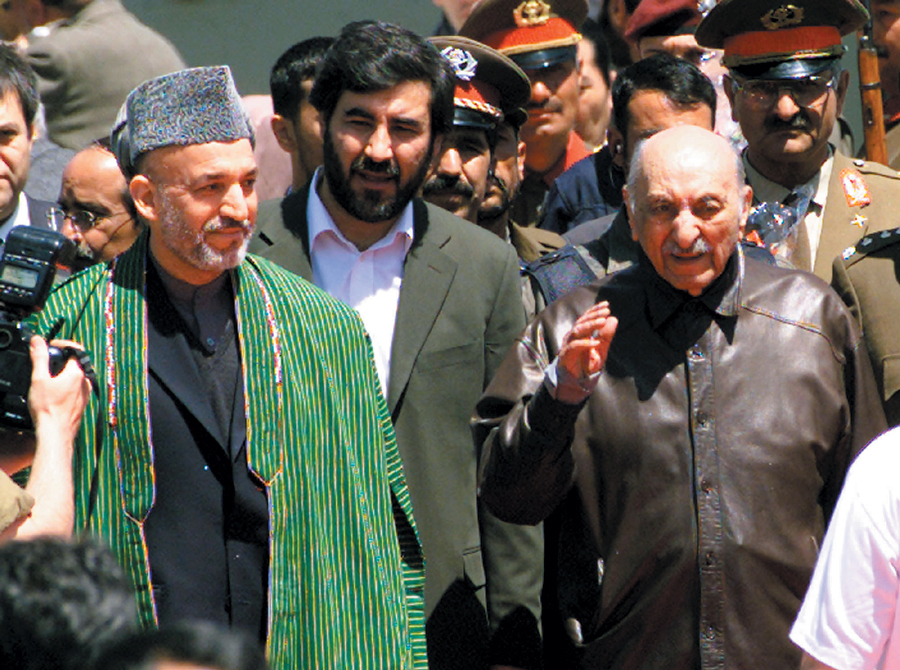
Karzai was elected to a second term in 2009. From 2011 to 2013, national peacekeeping and security duties were transferred to Afghan forces. International troops shifted into a supporting role. But Taliban and al-Qa`ida forces continued to fight international troops across the country.
Presidential elections were held in April 2014, but no candidate secured a majority of the vote. In June, the country held a runoff election between the two leading candidates, former surgeon Abdullah Abdullah and former Finance Minister Ashraf Ghani. The candidates accused each other of electoral fraud. After months of deadlock, the opponents signed a power-sharing agreement making Ghani the president and Abdullah, the chief executive, a newly created office.
In 2014, the United States and the North Atlantic Treaty Organization (NATO) formally ended their combat missions in Afghanistan. Nevertheless, thousands of American and NATO troops remained in the country in training and advisory roles. After 2014, renewed strength of the Taliban insurgency led the U.S. government to announce plans to keep troops stationed in Afghanistan beyond 2016. Later, U.S. troops resumed a combat role. In 2018, representatives of the United States and the Taliban began to hold talks on conditions under which U.S. troops might be withdrawn from the country. However, the Taliban resisted engaging in negotiations with the Afghan government.
In September 2019, a presidential election was held. According to preliminary results, Ashraf Ghani had won a slim majority. Abdullah Abdullah and some other opposition leaders disputed the results. In February 2020, the election commission announced that Ghani had won a majority of the votes. Ghani began his second term as president in March. Abdullah continued to claim election fraud and conducted a rival inauguration ceremony on the same day. In May, a new power-sharing agreement was reached. Ghani was recognized as president. Abdullah became chairman of a new High Commission for National Reconciliation with primary responsibility for negotiations with the Taliban.
Also in February 2020, the Taliban signed an agreement with the United States aimed at ending the war in Afghanistan. The Taliban agreed not to allow such terrorist organizations as al-Qa`ida and the Islamic State (ISIS) to operate from bases in the country, and the United States agreed to a gradual withdrawal of its troops. In September, representatives of the Taliban and the Afghan government began negotiations. However, threats and violence by the Taliban and other militant groups against supporters of the Afghan government soon mounted.
Taliban attacks aimed at controlling additional territory also increased in 2021, as U.S. and NATO troops began to withdraw. The Taliban advances sped up during the summer months, and hundreds of thousands of Afghans fled. The Afghan military collapsed before the Taliban advances. In August, several major cities fell to the Taliban. On August 15, Taliban forces entered and took control of Kabul. President Ashraf Ghani fled the country.
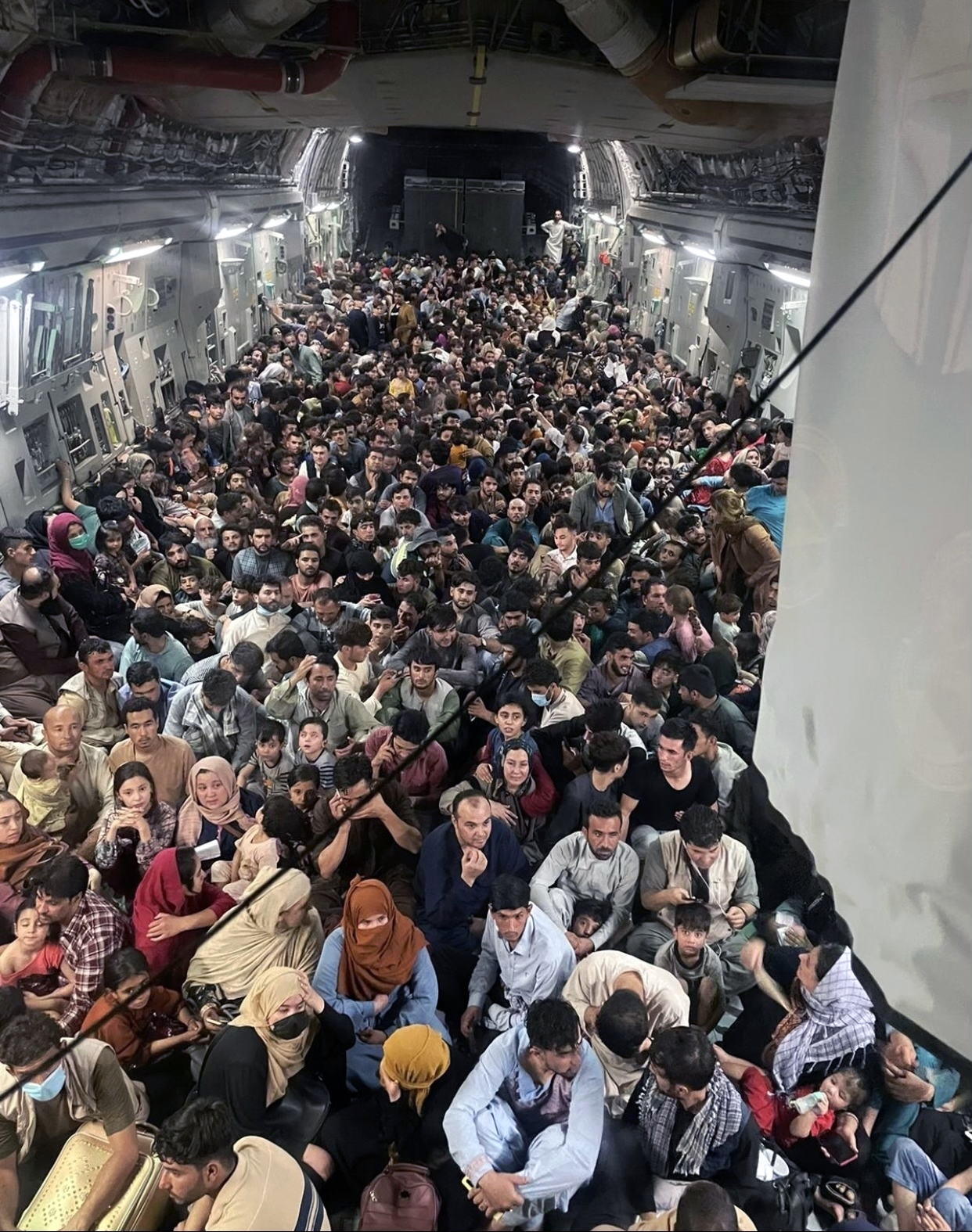
The displacement of thousands of Afghans from their homes, a loss of jobs and of foreign aid, and a serious drought all contributed to an economic collapse. By late 2021, Afghanistan faced a humanitarian crisis. The United Nations appealed to other countries to assist Afghanistan’s people. In addition, violence has continued. Attacks by ISIS-K have targeted both the Taliban, as rivals, and minority Shī`ite Muslims. Meanwhile, the Taliban have reimposed many restrictions, particularly on Afghan women, regarding clothing, education, and other personal activities.
In June 2022, an earthquake struck southeastern Afghanistan and killed more than 1,000 people. A similar number of people were killed in a series of earthquakes that struck western Afghanistan in October 2023.
